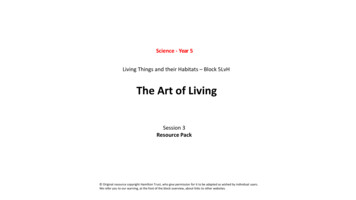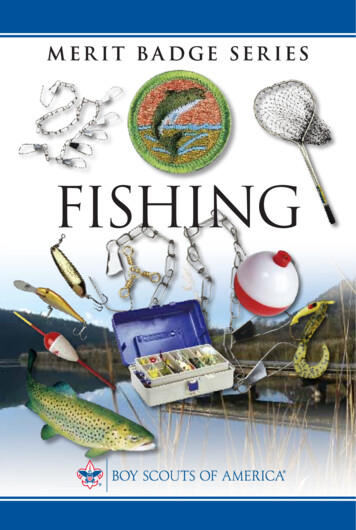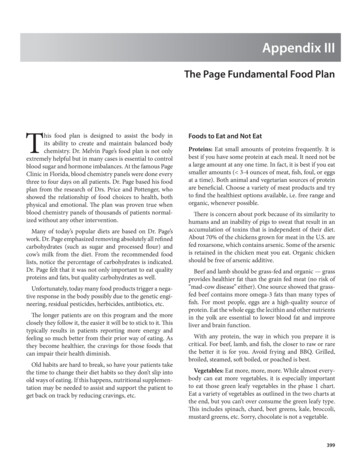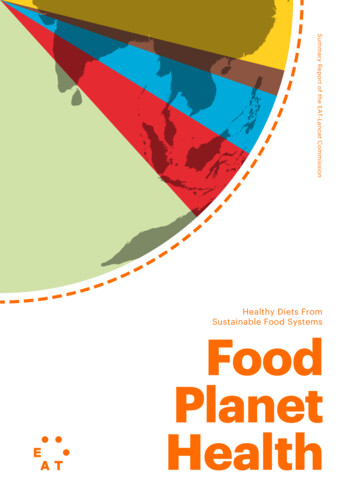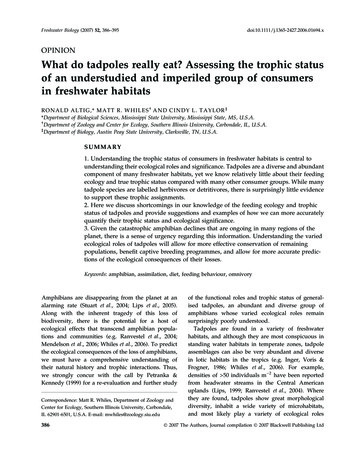
Transcription
Freshwater Biology (2007) 52, ONWhat do tadpoles really eat? Assessing the trophic statusof an understudied and imperiled group of consumersin freshwater habitatsRONALD ALTIG,* MATT R. WHILES† AND CINDY L. TAYLOR‡*Department of Biological Sciences, Mississippi State University, Mississippi State, MS, U.S.A.†Department of Zoology and Center for Ecology, Southern Illinois University, Carbondale, IL, U.S.A.‡Department of Biology, Austin Peay State University, Clarksville, TN, U.S.A.SU M M A R Y1. Understanding the trophic status of consumers in freshwater habitats is central tounderstanding their ecological roles and significance. Tadpoles are a diverse and abundantcomponent of many freshwater habitats, yet we know relatively little about their feedingecology and true trophic status compared with many other consumer groups. While manytadpole species are labelled herbivores or detritivores, there is surprisingly little evidenceto support these trophic assignments.2. Here we discuss shortcomings in our knowledge of the feeding ecology and trophicstatus of tadpoles and provide suggestions and examples of how we can more accuratelyquantify their trophic status and ecological significance.3. Given the catastrophic amphibian declines that are ongoing in many regions of theplanet, there is a sense of urgency regarding this information. Understanding the variedecological roles of tadpoles will allow for more effective conservation of remainingpopulations, benefit captive breeding programmes, and allow for more accurate predictions of the ecological consequences of their losses.Keywords: amphibian, assimilation, diet, feeding behaviour, omnivoryAmphibians are disappearing from the planet at analarming rate (Stuart et al., 2004; Lips et al., 2005).Along with the inherent tragedy of this loss ofbiodiversity, there is the potential for a host ofecological effects that transcend amphibian populations and communities (e.g. Ranvestel et al., 2004;Mendelson et al., 2006; Whiles et al., 2006). To predictthe ecological consequences of the loss of amphibians,we must have a comprehensive understanding oftheir natural history and trophic interactions. Thus,we strongly concur with the call by Petranka &Kennedy (1999) for a re-evaluation and further studyCorrespondence: Matt R. Whiles, Department of Zoology andCenter for Ecology, Southern Illinois University, Carbondale,IL 62901-6501, U.S.A. E-mail: mwhiles@zoology.siu.edu386of the functional roles and trophic status of generalised tadpoles, an abundant and diverse group ofamphibians whose varied ecological roles remainsurprisingly poorly understood.Tadpoles are found in a variety of freshwaterhabitats, and although they are most conspicuous instanding water habitats in temperate zones, tadpoleassemblages can also be very abundant and diversein lotic habitats in the tropics (e.g. Inger, Voris &Frogner, 1986; Whiles et al., 2006). For example,densities of 50 individuals m)2 have been reportedfrom headwater streams in the Central Americanuplands (Lips, 1999; Ranvestel et al., 2004). Wherethey are found, tadpoles show great morphologicaldiversity, inhabit a wide variety of microhabitats,and most likely play a variety of ecological rolesÓ 2007 The Authors, Journal compilation Ó 2007 Blackwell Publishing Ltd
1What do tadpoles really eat?(a)387(b)Fig. 1 (a) Diorama depicting functional diversity of tadpoles associated with lotic habitats in the Neotropics. From the top rightmoving clockwise, species depicted are: Thoropa miliaris, a semiterrestrial grazer that lives in hygropetric habitats; Cochranella granulosa,a detritivore that burrows in deposits of organic materials; Otophryne pyburni, a psammonic detritivore; Phasmahyla guttata, a nuestonicspecies with an umbelliform oral apparatus for feeding on the surface tension; Hyla armata, a suctorial species that grazes substratesin riffles and runs; Eleutherodactylus ridens, embryos of a direct developing species in litter accumulations at the axils of riparianplants, and; Phrynohyas resinifitrix, an omnivorous and oophagous species often found in tree holes. Original art by Kate Spencer, fromHoff et al. (1999). (b) Diorama depicting functional diversity of tadpoles associated with lentic habitats in the Neotropics. From the topmiddle moving clockwise, species depicted are: Hyla bromeliacia, a detritivore that lives in phytotelmata of bromeliads; Hyla microcephala, a midwater macrophagous tadpole; Scinax staufferi, a nektonic tadpole that scrapes biofilms and other materials from plantsand inorganic substrates; Rhinophrynus dorsalis, a filter-feeder that swims in schools; Leptodactylus pentadactylus, an omnivore that oftenpreys on smaller tadpoles, and; Bufo marinus, a benthic grazer.(Altig & Johnston, 1989; Fig. 1). However, tadpolesare often overlooked and understudied relative toother consumer groups such as fishes and macroinvertebrates in freshwater ecosystems, and the truetrophic status of many tadpole species remainsunknown (Altig & Johnston, 1989; Pryor & Bjorndal,2005a,b); basic information that is central to understanding their ecological significance and thus theconsequences of their loss. A more accurate understanding of the nutritional ecology of tadpoles willalso benefit captive breeding programmes, whichappear to represent the last hope for many decliningspecies (Mendelson et al., 2006). Further, manyamphibian declines have been linked to diseasessuch as chytridiomycosis and ranaviruses, and dietand feeding behaviours, particularly cannibalism andscavenging, could influence transmission and susceptibility.The feeding and trophic relations of macrocarnivorous tadpoles that often engulf entire organisms(e.g. Ceratophrys, Lepidobatrachus, Spea spp.; seeCrump, 1992) are relatively clear, and the diets ofsuspension-feeders (e.g. microhylids, pipids and rhinophrynids) require a separate discussion. Whileaddressing only the general feeding ecology ofrasping tadpoles, which constitute the bulk of tadpolediversity, herein we counter the poorly supportedconsensus that tadpoles function consistently asherbivores, and we present a heuristic discussion ofalternative ideas that is intended to catalyse muchneeded and increasingly urgent research in this areaof tadpole ecology.Classical studies of tadpole diets can provideinformation on feeding behaviours and functionalroles of tadpoles if sampling is carried out correctly,but these studies are often uninformative for assessing trophic status for four related reasons: (i) onlyingested materials (e.g. gut contents) are assessed,usually at relatively low magnification, with no ideaof relative digestibility; (ii) the complete taxonomic,calorific and nutrient compositions of consumedmaterials, and the nutritional needs of the tadpoles,are poorly known; (iii) sampling of comparativefood sources from the environment is either notÓ 2007 The Authors, Journal compilation Ó 2007 Blackwell Publishing Ltd, Freshwater Biology, 52, 386–395
388R. Altig et al.performed or inadequate (e.g. too coarse-grained)and biased towards autotrophic materials and (iv)little is known about the behavioural feeding ecologyof tadpoles (e.g. spatiotemporal patterns of foragingand biotic or abiotic factors that influence them).Investigators have been further thwarted by the lackof information on interspecific and ontogenetic changes in mouthpart operations and how the differencesin tadpole mouthpart configurations afford selectivefeeding.While some studies have provided important information on components of tadpole feeding behavioursand diets, information on assimilation and nutritionalecology is mostly lacking. It is well established thatdietary variables influence tadpole growth (e.g. Hegner, 1922; Steinwascher & Travis, 1983; Peterson &Boulton, 1999; Skelly & Golon, 2003), and sympatricspecies may differ in visible gut contents (Zhou,Zhang & He, 2005), which probably reflects differentfeeding sites or preferences. At the same time, weposit that the feeding habits and major energy andnutrient sources of typical rasping tadpoles in thefield remain essentially unknown. Ingested materialand that which is assimilated may differ substantially,as has been shown for numerous freshwater invertebrates (e.g. Cummins & Klug, 1979; Evans-White,Dodds & Whiles, 2003) and fishes (e.g. Bowen, Lutz &Ahlgren, 1995; Evans-White et al., 2003) that havebeen traditionally considered herbivores or detritivores. What is often described as the consummatorydiet of aquatic consumers may often serve only as asubstrate and harvestable carrier for assimilatedmaterial such as microbes and protozoans, components that are often not properly assessed in analysesof gut contents. Knowing what tadpoles ingest canprovide important insight into their functional roles(e.g. their contributions to the processing and transformations of basal resources such as changing particle sizes of organic materials through feeding andegestion), but this does not necessarily reflect theirtrophic status.Examinations of tadpole feces have been used toassess tadpole diets (e.g. Pavignano, 1989), but theseare also problematic as they produce a distortedimage because this material obviously contains primarily what remains after digestion, and the contributions of these materials to diets are possiblyinflated. Diatoms are particularly problematic becausetheir silicon frustules, structures that are easily seenand counted in these analyses, are very refractory inthe environment. The presence of abundant emptyfrustules in tadpole guts does not necessarily showthat they were ingested as live individuals. Amongother kinds of studies (e.g. Cowie & Hedges, 1996),there is a need for investigations in which tadpoles arefed various types of viable diatoms. By comparing thenumber of empty frustules in the food source and thefeces of tadpoles, we would gain insight into if andhow diatoms are actually digested.Tadpoles as herbivores and detritivoresThe dogma of tadpole herbivory probably stems fromthe frequent abundance of visible, algal-based items(i.e. green material) in their long guts, the successfulrearing of tadpoles on plant-based materials, and themechanics of the food-trapping structures designedfor particle capture (e.g. Wassersug & Hoff, 1979).Three counter-arguments set the stage for furtherdiscussion: (i) most tadpoles are more likely omnivorous at best; (ii) tadpole diets show great temporal andspatial variation and (iii) contrary to the generalconcept that is also often incorrect for many othertaxa, what tadpoles ingest (i.e. that which can becounted, measured and identified with standardtechniques) is an improper proxy for what theyactually assimilate.Inexact definitions of food materials and semanticissues in the tadpole feeding literature compoundproblems, even though knowledge of the biology ofthe various food sources of tadpoles is just asimportant to our understanding of their ecologicalroles as is the biology of the tadpoles themselves. Forexample, ‘periphyton’ is often used to describe theprolific and complex communities that develop onsubmerged substrata, even though significant heterotrophic components are often present (Lock et al.,1984). Hence, much of the ‘periphyton’ referred toin the tadpole feeding literature should be moreaccurately referred to as epilithon. ‘Aufwuchs’ and‘biofilm’ are also better descriptors because thedominance of autotrophs is not implied. Bacterialand fungal constituents of these materials are seldomconsidered in the tadpole feeding literature, eventhough they may be equally or more importantcomponents in the epilithon in many systems, particularly those of more oligotrophic habitats (e.g. Stock &Ward, 1989; Hall, 1995; Hall & Meyer, 1998).Ó 2007 The Authors, Journal compilation Ó 2007 Blackwell Publishing Ltd, Freshwater Biology, 52, 386–395
1What do tadpoles really eat?The dynamic nature of epilithic food resources thatare available to tadpoles requires frequent and finegrained sampling. Epilithon starts to form withinhours of the entry of a new substrate into the water,and although they may look grossly similar, epilithiccommunities pass through succession rapidly andshow great spatiotemporal variation relative to every2 factor in the environment (Lock et al., 1984; Neely &Wetzel, 1997). Hence, sampling this material once inthe field, or at the beginning or end of an experiment,usually will be inadequate for assessing food resourceavailability to tadpoles.Some would argue that tadpoles are herbivoresbecause they have a long gut, field-collected specimens often have green material in their guts, andreared individuals usually are fed plant-based materials (e.g. Alford, 1999). However, the long gut tract oftadpoles probably compensates for the weak to absentperistalsis (Naitoh et al., 1990), and processing of plantmaterials that are fed to tadpoles typically involvesmodifications such that the materials no longer havethe characteristics of natural plant material. In fact,many commercial foods that have been used intadpole rearing contain animal tissues [e.g. FrogBrittle (Nasco Science, Fort Atkinson, Wisconsin,U.S.A.) and TetraminÒ (Tetra Werke, Melle, Germany)]. The high propensity for plant-based foods tofoul the water in rearing chambers and aquaria alsodemonstrates that they are excellent substrates formicrobial and protozoan growth.Rasping tadpoles can suspension feed underproper circumstances of particle abundance (e.g.Seale & Beckvar, 1980; Seale, 1982), and because ofthe obvious differences from attached or depositedbenthic materials, phytoplankton presents a differentfeeding scenario. Phytoplankton has been postulatedas an important food source in some studies. Johnson(1991) related growth of Acris tadpoles with phytoplankton abundance, but one must assign cause withcaution. This correlation may well have been linkedto simultaneous blooms of bacteria, protozoans andsmall metazoans (see Test & McCann, 1976) thatwould be more important within the benthic microhabitat of Acris tadpoles. Pryor (2003) found thatbullfrog (Rana catesbeiana) tadpoles showed nogrowth over an 8-day period when fed three different species of algae, including two single-celled,planktonic species, although growth was evident inindividuals fed Anabaena flos-aquae, a nitrogen-fixing389filamentous blue–green alga that is relatively high inprotein.Those species that do derive significant nutritionfrom autotrophic sources are probably assisted by gutflora. Pryor (2003) and Pryor & Bjorndal (2005a,b)recently described the mechanism and site of microbial fermentation in bullfrog tadpoles, the firstdescription of gastrointestinal fermentation in amphibians. This important finding enhanced earlier ideason symbionts in tadpole guts (e.g. Battaglini & Boni,1967; Beebee & Wong, 1992; Lajmanovich, Emiliani &Peltzer, 2001). However, little is currently knownabout this digestive activity in tadpoles, and furtherresearch may show that it is of common occurrence.As with other species that traditionally have beenconsidered herbivorous, tadpoles that might beconsidered detritivores may gain most of theirnutrition from non-autotrophic sources and shouldnot be considered herbivores in any strict sense.Detritus is mostly composed of degraded plantmaterials, but this material often bears little resemblance to the original plant tissue in terms of itsstructure and nutritional content. Much of the nutritional value of detritus may stem more from associated microbes than the particles per se (e.g. Cummins& Klug, 1979; Bowen, 1980; Arsuffi & Suberkropp,1986), and fungal biomass can account for 18–23% ofthe mass of leaf detritus in headwater streams(Methvin & Suberkropp, 2003). As such, tadpoles thatingest detritus should not be considered herbivoresbecause they are more likely assimilating primarilymicrobes and associated extracellular materials, ashas been demonstrated for many other freshwaterdetritivores (Cummins & Klug, 1979; Barlocher,1985; Rossi, 1985; Graca, Maltby & Calow, 1993).As a recent example for tadpoles, stable C and Nisotope analyses of centrolenid tadpoles and theirpresumed food source of fine benthic detritus inPanamanian streams indicated that these tadpoleswere assimilating primarily microbes rather than thedetritus they ingested (Hunte-Brown, 2006; Whileset al., 2006).Tadpoles as carnivoresRecent evidence suggests that generalised, raspingtadpoles incorporate a variety of animal materials intotheir diet, and cannibalism and scavenging are welldocumented for a variety of tadpole taxa (Crump,Ó 2007 The Authors, Journal compilation Ó 2007 Blackwell Publishing Ltd, Freshwater Biology, 52, 386–395
390R. Altig et al.1983, 1992). This labile, highly nutritious material cancontribute disproportionately to growth and production of freshwater omnivores, even as a small component of the diet (e.g. omnivorous freshwater fishand invertebrates: Benke & Wallace, 1980; EvansWhite et al., 2003). As an example, a recent study ofstonerollers (Campostoma anomalum), stream-dwellingminnows that are traditionally considered herbivoresor omnivores, indicated that animal material (primarily invertebrates) that made up only about 6% of gutcontents accounted for 21% of their production(Evans-White et al., 2003). In one of the originalanalyses of the trophic basis of production of freshwater consumers, Benke & Wallace (1980) demonstrated that animal material accounted for about 80%of the production of a net-spinning caddisfly community, freshwater insects that were traditionally considered detritivores/omnivores. In the case oftadpoles, studies indicate that individuals that ingestanimal material grow faster than those that do not(Crump, 1990; Heinen & Abdella, 2005), but quantitative information on the relative contributions ofanimal material to tadpole nutrition and productionare still needed.Using stable isotope techniques, which account forassimilation rather than just ingestion, Schiesari (2004)examined tadpole diets in wetlands in Michigan andnoted that Rana catesbeiana, R. clamitans, R. pipiens andR. sylvatica tadpoles consumed and assimilated substantial amounts of animal food, and suggested thatlarval R. catesbeiana were functioning as predators.Given that other comprehensive studies suggestbullfrog tadpoles are herbivores (e.g. Pryor & Bjorndal, 2005a,b), these observations underscore thepotential for great spatiotemporal variation in tadpolediets and the clear need for further study. HunteBrown (2006) and Whiles et al. (2006) also used stableisotope techniques to examine the food web of anupland Panamanian stream and found that a varietyof tadpoles in these systems, particularly Rana wars3 zewitschii and Colostethus spp. had stable isotopicsignatures that suggested they consumed some animal material; the difference between the d15N oftadpoles and algal resources in this stream was muchhigher than the 2& fractionation per trophic step thatis typical of these streams (Kilham & Pringle, 2000).Studies of tadpoles that account for ecologicalefficiencies (e.g. Benke & Wallace, 1980; Evans-Whiteet al., 2003), along with ingestion, will allow us toquantitatively assess the potential importance ofcarnivory in tadpole nutrition.Tadpole feeding behaviourInformation on feeding behaviours is also central tounderstanding the ecological roles of tadpoles becausefeeding behaviour is often linked to functional roles(e.g. altering resource availability or quality for otherconsumers) and can result in both positive andnegative interactions with other consumers. Detailedobservations on feeding behaviours of tadpoles arestill uncommon, although there is increasing evidencethat tadpoles in many systems can act as ecosystemengineers that greatly modify resources and/or influence other consumers (Kupferberg, 1997; Flecker,Feifarek & Taylor, 1999; Ranvestel et al., 2004; Whileset al., 2006).Although interactions between freshwater grazersare often competitive, recent evidence from a neotropical stream suggests that, at least in some cases,tadpoles may facilitate other, smaller grazers. Usingelectric fences to experimentally exclude tadpolesfrom artificial substrates in a Panamanian stream,Ranvestel et al. (2004) found that grazing mayflieswere significantly more abundant where tadpoleswere allowed to feed. This pattern was attributed tofeeding and bioturbation by tadpoles, which clearedorganic and inorganic sediments from substrates andexposed underlying epilithon for mayflies to graze.This result provides intriguing evidence for myriadpotential interactions that tadpoles may have withgrazers and other consumer groups in freshwaterhabitats.Kupferberg (1997) examined the influence of Ranaand Hyla tadpoles on algae and grazing insects in aCalifornia stream and found that each had verydifferent effects on ecosystem structure and function.For example, while Rana greatly increased algalbiomass on stream rocks and increased primaryproduction per unit area by 10%, Hyla reducedprimary production per unit area by 18%. Theseresponses were attributed to feeding activities of thetadpoles, not nutrient recycling. More importantly,significant differences in algal responses to the feeding activities of the two genera underscore the needfor taxon-specific information on feeding behavioursand associated ecological effects, as taxa often lumpedas ‘grazers’ or similar can have very different effects.Ó 2007 The Authors, Journal compilation Ó 2007 Blackwell Publishing Ltd, Freshwater Biology, 52, 386–395
1What do tadpoles really eat?The ability of the tadpole gut to change structurerelative to diet suggests that acceptable diets can varyconsiderably (e.g. Horiuchi & Koshida, 1989), and onewould thus suspect that digestive enzymes areinducible. For example, Bufo periglenes, which is nowpresumed extinct, had relatively few, but large eggsand developed in what are considered oligotrophicpools based on the lack of autotrophic production(Crump, 1989). However, if these tadpoles fed fromthe microbial and fungal realm of organisms insteadof the presumed autotrophic sources, the oligotrophicstatus of these habitats was irrelevant to the tadpoles.Because unfed B. periglenes tadpoles developednormally in laboratory tests and metamorphosed insimilar time periods as fed tadpoles, Crump (1989)concluded that they could develop facultatively ononly yolk reserves. This may be true to some degree,but this may also demonstrate the flexibility thattadpoles have to adopt alternative feeding strategies;the unfed tadpoles could have switched to microbialprotozoan food sources and perhaps never noticed thepresumed lack of food. Common bacteria have generation times ranging from 11 to 75 min (Atlas, 1997)and could easily provide sufficient food, especially asfecal and excretory products built up and provided agrowth medium between water changes.Changes in tadpole feeding behaviour and growthresponses probably signal a change in relative abundances of acceptable food items, and some behaviourspresent interesting signals beyond the actual acts.What conditions stimulate alternative behaviours andwhat is gained: digging feeding pits (¼tadpole holesor nests; Black, 1971, 1974), feeding off the surfaces ofother living tadpoles, feeding inverted at the surfacefilm, feeding on the sides of research containers whenabundant artificial food is available on the bottom,switching from rasping to suspension feeding, andavidly eating carrion? These changes in feedingbehaviour often occur in situations where we mightevaluate the abundance of food, but in reality theymay be more related to food quality issues. Studiesthat focus on food quantity and quality (e.g. C/Nratios, caloric content) will provide much neededinformation on factors dictating tadpole feedingbehaviours.Using studies by Kupferberg (e.g. Kupferberg,Marks & Power, 1994), as an example, we know thattadpoles feed preferentially and perform differentiallyon specific food sources. Although these types of391studies can provide useful information, they oftenremove or reduce the choices that the tadpoles have,and what is deduced to be best for a given species oftadpole may only be the best of the choices presented.Further, indications that tadpoles grow better onperiphyton than the macrophyte leaves on which theperiphyton grow (Kupferberg et al., 1994) is noteworthy, but in fact we do not know what components ofthe diet produced the enhanced response. Here again,subsequent studies that build on these results byquantifying food quality, assimilation, tadpole nutrition, and/or the trophic basis of tadpole productionwill illuminate mechanisms underlying feeding behaviour and growth responses.Future research needsOur intention is to draw attention to and stimulateresearch on an increasingly critical gap in our knowledge of an important and imperiled group ofconsumers in freshwater habitats. Given the currentsituation of catastrophic declines, extirpations andextinctions, we feel a sense of urgency regarding ourunderstanding, or lack thereof, of the feeding ecologyand trophic status of tadpoles. Their losses can beexpected to influence freshwater systems in manyways, but predicting the consequences and knowingwhat to look for is difficult without this basicinformation. We have tried to point out majorperceived deficiencies in our current knowledgeand, at the least, demonstrate that there is certainlyno consensus regarding tadpole feeding ecology.Hence, for many tadpole taxa, we are currently leftwith the unsatisfactory designation of omnivore, withlittle quantitative information on the relative importance of the various food types.A discussion of every way to attack the complexquestions regarding tadpole feeding ecology is beyond our scope here, but some particularly promisingapproaches are worth mention. The meager andcontradictory data on digestive enzymes (e.g. Kuntz,1924; Altig et al., 1975; Carroll, Seneviratne & Ruibal,1991) need to be revisited with modern techniques.Additional studies on digestive ecophysiology (e.g.Toloza & Diamond, 1990; Beebee & Wong, 1992) inassociation with digestive facilitators would alsogreatly enhance our knowledge. Recent documentation of microbial fermentation in bullfrog tadpoles(Pryor, 2003; Pryor & Bjorndal, 2005a,b) supportsÓ 2007 The Authors, Journal compilation Ó 2007 Blackwell Publishing Ltd, Freshwater Biology, 52, 386–395
392R. Altig et al.hypotheses regarding gut symbionts in tadpoles, andprovides a foundation for similar, descriptive work ofthis nature on other taxa. Comparative studies oftadpoles that live in different habitats such as streams,ponds, tree holes and desert pools would also beillustrative. These habitats differ in the amount andkinds of food materials, and the duration of larvalstages varies widely among them.Stable isotope techniques (e.g. Peterson, 1999; Post,2002) are promising for assessing trophic status oftadpoles because they reflect assimilation of materialsover time rather than just ingestion at a given point intime, as is the case for gut content analyses. Recentinvestigations by Schiesari (2004); Hunte-Brown(2006) and Whiles et al. (2006) demonstrate the valueof analyses of natural abundances of C and N isotopesin food resources and tadpoles for assessing tadpoletrophic status. Enrichment studies, such as 15N additions to ponds or streams (e.g. Hall, 1995; Hall,Peterson & Meyer, 1998; Raikow & Hamilton, 2001),are particularly promising as they serve as a tracer forfood webs and allow for quantification of the role ofconsumers in nutrient cycling; enrichment studies insystems where tadpoles are diverse and abundantwould provide valuable information on ecologicalroles.Although more time consuming and expensive thanstable isotope analyses, examination of polyunsaturated fatty acid profiles in food web components isalso promising for assessing tadpole diets and trophicstatus. Like isotopic ratios, fatty acid markers can beused to link consumers to food resources, and theyreflect assimilation over time. Fatty acid analyses havebeen successfully used to assess food web linkages inmarine, lake and stream systems (Ahlgren et al., 1997;Napolitano et al., 1997, 1999; Muller-Navarra et al.,2000; Stübing, Hagen & Schmidt, 2003; Sushchik et al.,4 2003), and these analyses can provide detailed taxonomic information such as the specific types of algaethat consumers assimilate (e.g. Parrish et al., 1995;Napolitano et al., 1997, 1999). Fatty acid analyses alsogive insight into the nutritional quality of variousfood sources.Regardless of the specific techniques used, studiesof tropical tadpole assemblages are most needed andwould be of most value because taxonomic diversity,and thus presumably trophic diversity, is highest anddeclines are most widespread and catastrophic in thetropics. While detailed information on tadpole dietsand/or trophic status from any region is obviously avaluable contribution, there is clearly an urgent needin the tropics, where we are currently losing entireassemblages before knowing anything about theirecological roles.AcknowledgmentsT. Halliday, C. Townsend and an anonymous reviewer provided valuable comments that greatlyimproved this manuscript. Parts of this effort werefunded by National Science Foundation grant DEB#0234386.ReferencesAhlgren G., Goedkoop W., Markensten H., Sonesten L. &Boberg M. (1997) Seasonal variations in food qualityfor pelagic and benthic invertebrates in Lake Erken –the role of fatty acids. Freshwater Biology, 38, 555–570.Alford R.A. (1999) Ecology: resource use, competition,and predation. In: Tadpoles: The Biology of AnuranLarvae (Eds R.W. McDiarmid & R. Altig), pp. 240–278.University of Chicago Press, Chicago.Altig R. & Johnston G.F. (1989) Guilds of anuran larvae:relationships among developmental modes, morphologies, and habitats. Herpetological Monographs, 3, 81–109.Altig R., Kelly J.P., Wells M. & Phillips H. (1975)Digestive enzymes of s
Keywords: amphibian, assimilation, diet, feeding behaviour, omnivory Amphibians are disappearing from the planet at an alarming rate (Stuart et al., 2004; Lips et al., 2005). Along with the inherent tragedy of this loss of biodiversity, there is the potential for a host of ecological effects that transcend amphibian popula-
